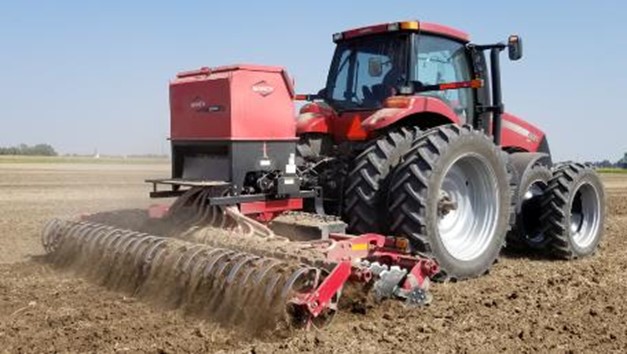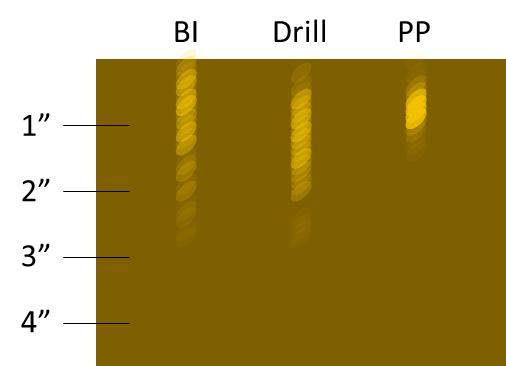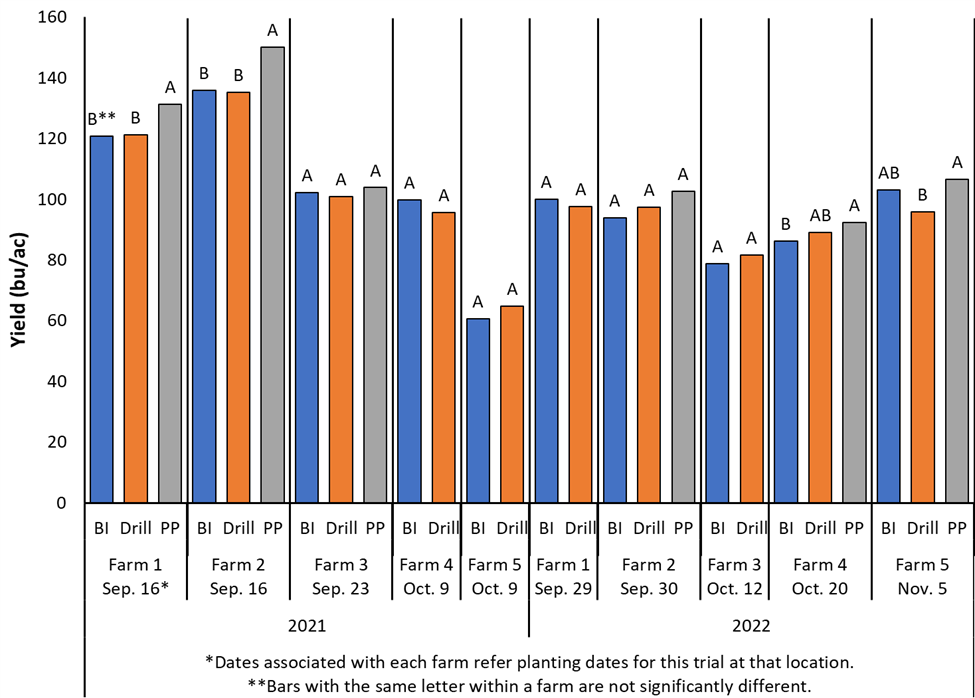Alternative planting strategies for maximizing yield potential in winter wheat
Farmers are looking for ways to accelerate planting of winter wheat to reduce weather-related planting delays. Meanwhile, a transition to precision planting in narrow rows may improve yields.

Timely planting of winter wheat is important for achieving maximum yield potential. Significant yield loss occurs when planting is delayed beyond mid-October (Figure 1). Unfortunately, frequent rainfall in Michigan during the autumn months tend to delay field operations. The need in many cases to wait until soybeans are harvested before planting wheat adds an additional layer of difficulty. Due to these challenges, area planted to wheat was reduced by 23% in 2021.
To address this challenge, some farmers are experimenting with an alternative planting method known as broadcast incorporation (Figure 2), which allows them to cover more acres in a shorter amount of time. Broadcast incorporation consists of broadcasting seed over the soil surface, followed by incorporation using a shallow tillage implement. This allows wheat to be planted at much faster speeds than with a traditional grain drill, as well as providing the potential for wider swaths. The operation can be further sped up by mounting a spreader on top of the tillage implement in such a way that the seed is broadcasted just ahead of the last gang.

The biggest concern with broadcast incorporation is that the random distribution of seeds in the soil profile results in a highly variable seed depth. Figure 3 shows the variability of seeding depths achieved using various planting methods, including broadcast incorporation. Increased variability in seeding depth can result in poor germination and crown development, reduced tillering, and more variable plant development.

Another planting method that provides for greater control over seed placement is precision planting. Precision planters have become standard for planting crops such as corn and soybeans, due to their ability to provide uniform depth, as well as singulation and precise metering of the seeds. Small plot research in winter wheat at Michigan State University has shown a benefit of precision planting in narrow rows (e.g., 5 inches, compared to the 7.5 inches that is typical for grain drills). Along with the previously mentioned benefits of precision planting, narrower rows allow us to achieve something closer to the optimal spatial distribution of uniform spacing around each plant (Figure 4). By reducing the relatively wide space between rows, we increase the relatively small spacing between plants within the row at a given seeding rate.

The Michigan State University Cropping Systems Agronomy lab is currently conducting on-farm trials to evaluate the performance of broadcast incorporation and precision planting and to compare them against a traditional grain drill. This study, to date, has included ten different locations over two years. So far, despite a definite increase in depth variability, no yield penalty has been demonstrated to result from the use of broadcast incorporation when compared with a traditional grain drill (Figure 5). This may be the result of a 24–37% increase in the number of effective tillers (i.e., tillers that produce heads with grain) cancelling out any yield penalty resulting from the increased variability in seeding depth.
This increase in the number of tillers likely goes back to the aforementioned optimal plant distribution consisting of uniform spacing all the way around each plant. By randomly distributing the seed over the soil surface, we can break away from the row pattern with high density within rows and low density across rows, achieving something that more closely resembles our optimal distribution (Figure 4). This allows plants to make more efficient use of the space available to them, resulting in increased tillering.
There was a concern after the 2020 – 21 growing season that broadcast incorporation may begin to show a yield penalty compared to a grain drill under late planting. However, two late-planted locations (Oct. 20 and Nov. 5) in the 2021 – 22 growing season did not show this to be the case.

While there has been no real difference between broadcast incorporation and drill, narrow-row precision planting has shown an 8 – 11% yield benefit over drill at three out of six site years (Figure 5). This has not been associated with an increase in the number of tillers and is more likely a result of improved uniformity in seed placement and associated uniform tiller development, leading to increase in kernels per head and/or kernel weight.
Based on what has been observed so far, broadcast incorporation appears to be a viable option for farmers whose priority is getting wheat in the ground as quickly as possible. While there are concerns about the effects of a random distribution of seeds—especially in terms of seeding depth—these effects have failed to show up in field trials during the last two growing seasons. On the other hand, some farmers may benefit from increased yields by transitioning from traditional wheat planting technologies to precision planting in narrow rows. This method continues to lead other planting methods with the highest yields in our trials over the last four years.
Meanwhile, some questions remain to be answered, such as whether the performance of broadcast incorporation will hold up during more severe winters than we have experienced recently. Trials will be continued in the 2022-23 season and a detailed interpretation of data will be shared with farmers at project conclusion. Funding for this project is provided by the Michigan Wheat Program and Project GREEEN.



 Print
Print Email
Email


